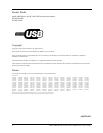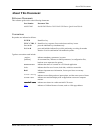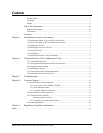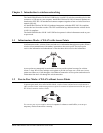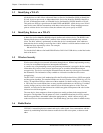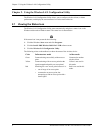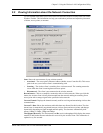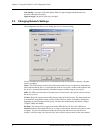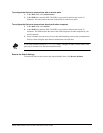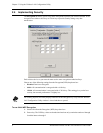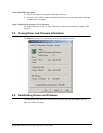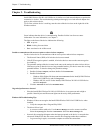
Chapter 1. Introduction to wireless networking
2 Intel® PRO/Wireless 2011B LAN USB Device Users Guide
1.3 Identifying a WLAN
All the devices on a WLAN use a Network Name, or Service Set Identifier (SSID) to identify the
WLAN. In peer-to-peer mode, an Independent Basic Service Set Identifier (IBSSID) identifies a
WLAN. In infrastructure mode, an Extended Service Set Identifier (ESSID) identifies a WLAN.
This guide uses SSID as a general term for both ESSID and IBSSID. All the devices on a WLAN
must use the same SSID to communicate with other wireless devices. When installing an access
point or wireless device in a wireless client, the software asks you to specify an SSID.
1.4 Identifying Devices on a WLAN
A Basic Service Set Identifier (BSSID) uniquely defines each wireless device. The BSSID is the
Ethernet Media Access Control (MAC) address of the wireless device installed in the wireless
client. The MAC address is permanently set when the device is manufactured. MAC addresses
determine the device sending or receiving data. A MAC address is a 48-bit number written as six
hexadecimal bytes separated by colons. For example:
00:A0:F8:24:9A:C8
To view the MAC address of an Intel® PRO/Wireless 2011B LAN USB device, see the label on the
back of the device.
1.5 Wireless Security
Wireless networking devices transmit information through the air. Without implementing security,
it is easy for an unauthorized person to intercept the information.
A common way of implementing security and protecting information is encryption. Before sending
information, the wireless client or access point encrypts or scrambles information using an
encryption key. The device receiving the information uses the same key to decrypt or unscramble
the information. The information is only readable to wireless devices that have the correct
encryption key.
The IEEE 802.11 wireless LAN standard specifies the Wired Equivalent Privacy (WEP) encryption
and decryption algorithm. The standard includes two levels of security, using a 40-bit key or a 128-
bit key. To implement WEP, use either one of these methods. For better security, use a 128-bit key.
A 128-bit key has several trillion times as many possible combinations as a 40-bit key. For added
security, change your keys often. Some vendors refer to 40-bit encryption as 64-bit. These are
identical. A wireless device that claims to have 40-bit encryption interoperates with a device that
claims to have 64-bit encryption.
The same device, host computer or front-end processor usually performs both encryption and
decryption. The algorithm, like the pattern of a lock, is standardized and may be used by anyone,
but the encrypted data is unreadable without the appropriate key, which is known only by the
sender and receiver of the transmitted data. You should change your keys often for added security.
1.6 Radio Basics
IEEE 802.11 networking devices transmit and receive radio signals. Users communicate with the
network by establishing radio links between mobile devices and access points, or between each
other.




